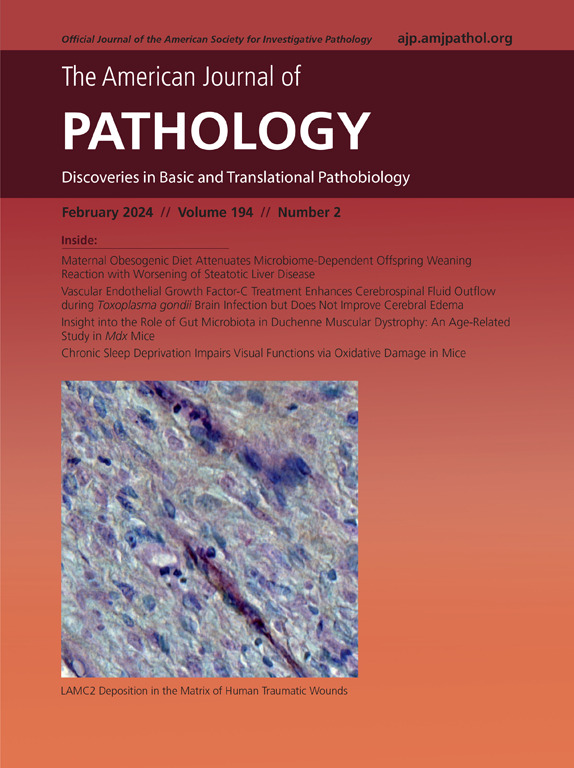铜绿假单胞菌和正常菌落金黄色葡萄球菌的慢性联合感染会导致囊性纤维化大鼠肺部结构损伤。
IF 3.6
2区 医学
Q1 PATHOLOGY
引用次数: 0
摘要
囊性纤维化(CF)呼吸系统的预后在很大程度上受到感染并发症的影响。铜绿假单胞菌和金黄色葡萄球菌是囊性纤维化肺部最常见的定植菌,它们经常重叠在一起,造成与严重疾病相关的慢性持续性合并感染。然而,人们对铜绿假单胞菌和金黄色葡萄球菌合并感染的动态及其对囊性纤维化肺结构损伤发展的影响知之甚少。此外,金黄色葡萄球菌的小菌落变异体(SCVs)与 CF 患者的铜绿假单胞菌感染有关,但它们在疾病进展中的作用在很大程度上还不清楚。在这项研究中,CF 大鼠被用来模拟铜绿假单胞菌和金黄色葡萄球菌的慢性肺部合并感染,使用临床和实验室衍生的正常菌落和 SCV 金黄色葡萄球菌菌株来评估表型对临床结果的影响。同时感染两种表型的临床衍生金黄色葡萄球菌的大鼠肺部炎症加重,但只有铜绿假单胞菌和临床正常菌落金黄色葡萄球菌的组合才会导致肺部结构衰退,包括粘液阻塞和支气管扩张。在回归分析中,损伤与铜绿假单胞菌的较高负担相关,表明正常菌落金黄色葡萄球菌和铜绿假单胞菌的慢性联合感染可能会支持由铜绿假单胞菌驱动的CF肺功能衰退,而当联合感染的金黄色葡萄球菌表现为SCV表型时,可能会避免这种情况。本文章由计算机程序翻译,如有差异,请以英文原文为准。
Chronic Coinfection with Pseudomonas aeruginosa and Normal Colony Staphylococcus aureus Causes Lung Structural Damage in the Cystic Fibrosis Rat
Cystic fibrosis (CF) respiratory outcomes are heavily influenced by complications of infection. Pseudomonas aeruginosa and Staphylococcus aureus are the most common colonizers of the cystic fibrosis lung, and frequently overlap to cause chronic and persistent coinfections associated with severe disease. However, the dynamics of P. aeruginosa and S. aureus coinfection and its impacts on the development of CF lung structural damage are poorly understood. Additionally, small colony variants (SCVs) of S. aureus have been associated with P. aeruginosa infections in people with CF, but their role in disease progression is largely unknown. In this work, the CF rat was used to model chronic lung coinfection with P. aeruginosa and S. aureus, using clinically and laboratory-derived normal colony and SCV strains of S. aureus to evaluate the impact of phenotype on clinical outcomes. Rats coinfected with clinically derived S. aureus of both phenotypes experienced increased inflammation in the lung. However, only the combination of P. aeruginosa and clinically normal colony S. aureus led to lung structural decline, including mucus obstruction and bronchiectasis. Regression analyses showed that the damage was associated with a higher burden of P. aeruginosa. These data indicate that chronic coinfection with normal colony S. aureus and P. aeruginosa may support the progression CF lung decline driven by P. aeruginosa, which might be avoided when coinfecting S. aureus exhibits the SCV phenotype.
求助全文
通过发布文献求助,成功后即可免费获取论文全文。
去求助
来源期刊
CiteScore
11.40
自引率
0.00%
发文量
178
审稿时长
30 days
期刊介绍:
The American Journal of Pathology, official journal of the American Society for Investigative Pathology, published by Elsevier, Inc., seeks high-quality original research reports, reviews, and commentaries related to the molecular and cellular basis of disease. The editors will consider basic, translational, and clinical investigations that directly address mechanisms of pathogenesis or provide a foundation for future mechanistic inquiries. Examples of such foundational investigations include data mining, identification of biomarkers, molecular pathology, and discovery research. Foundational studies that incorporate deep learning and artificial intelligence are also welcome. High priority is given to studies of human disease and relevant experimental models using molecular, cellular, and organismal approaches.

 求助内容:
求助内容: 应助结果提醒方式:
应助结果提醒方式:


